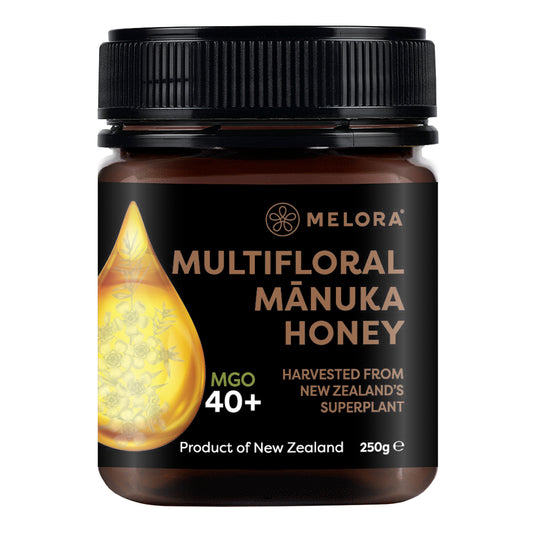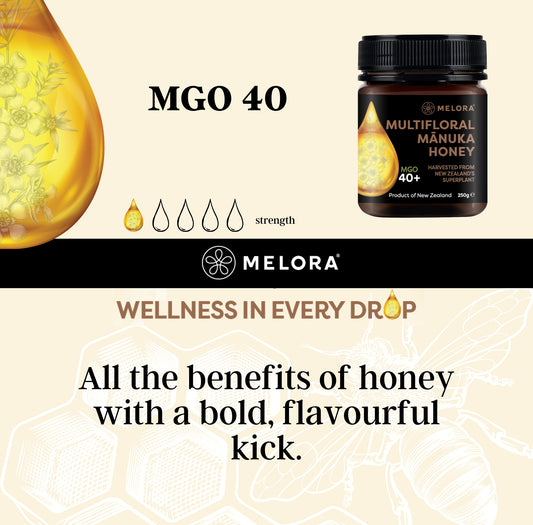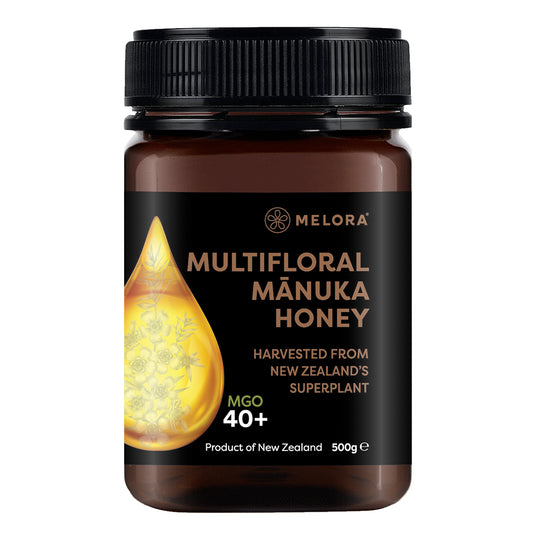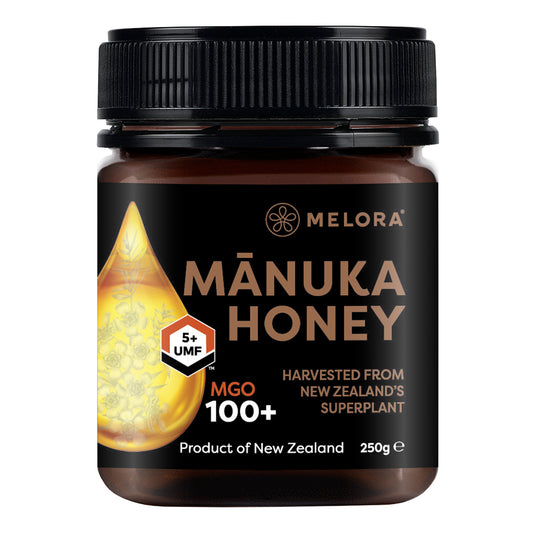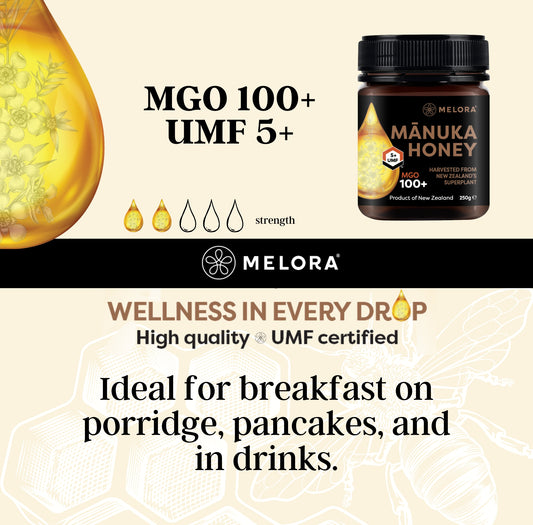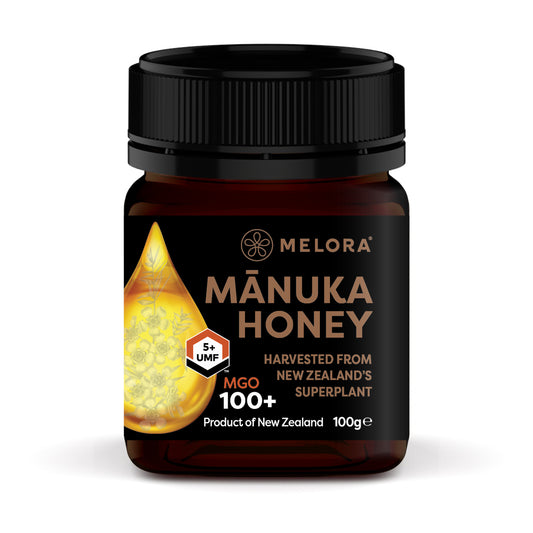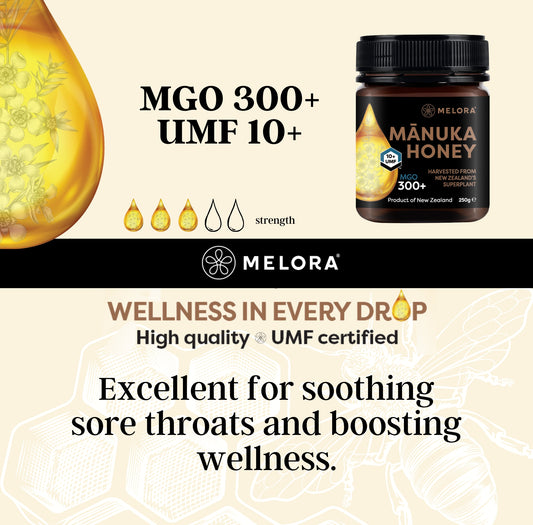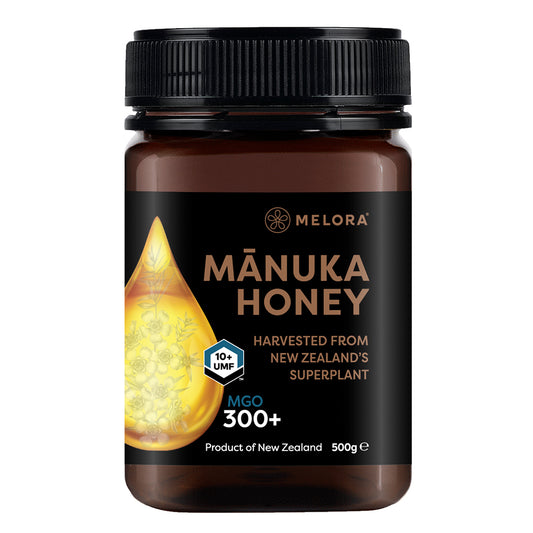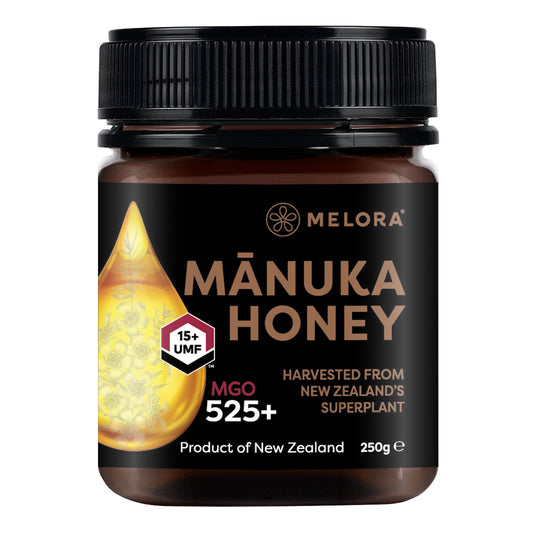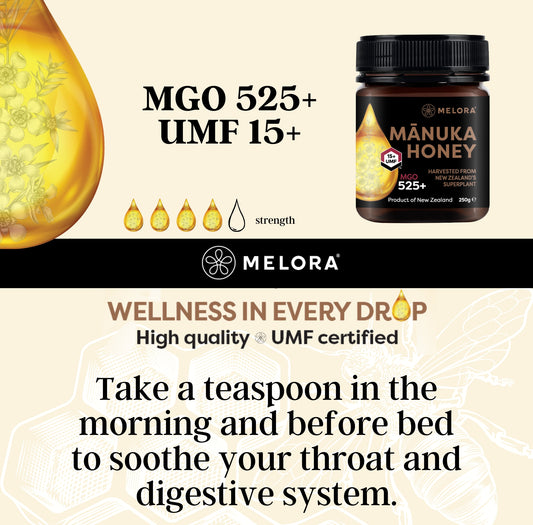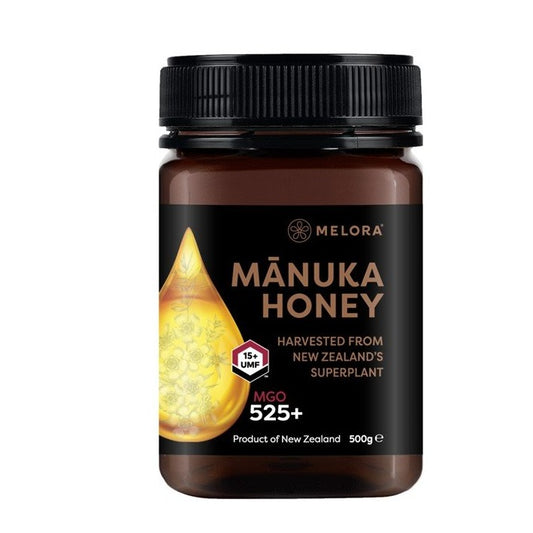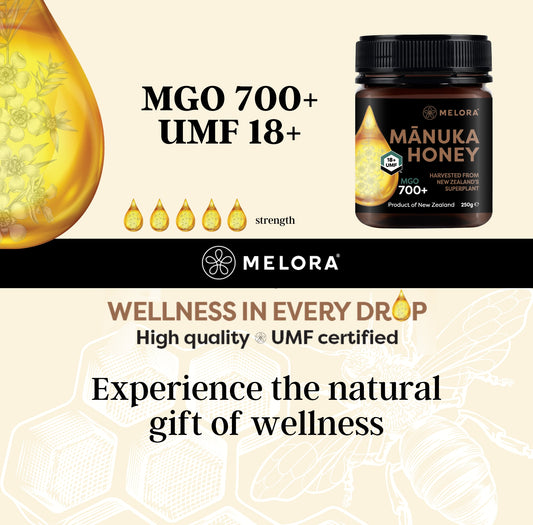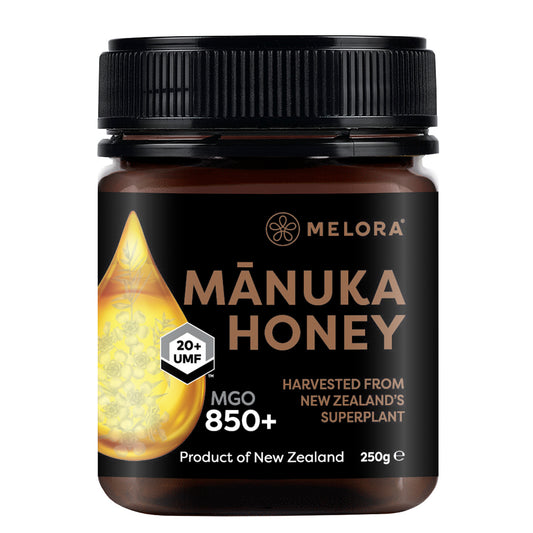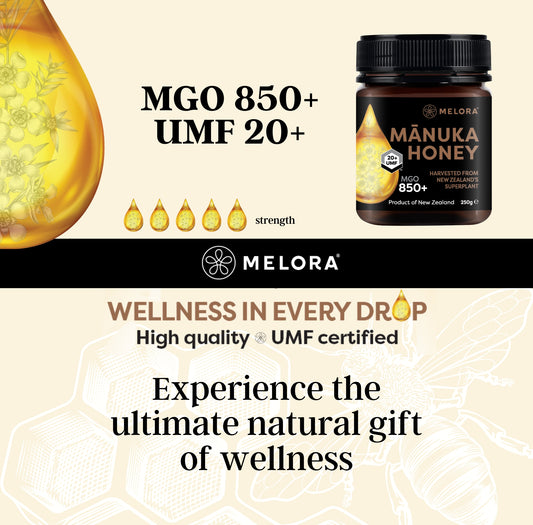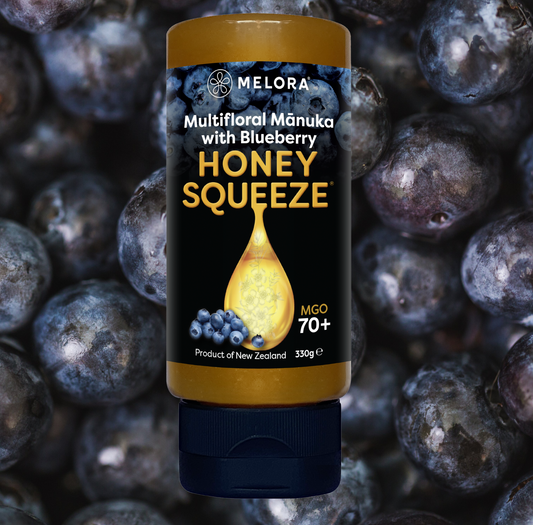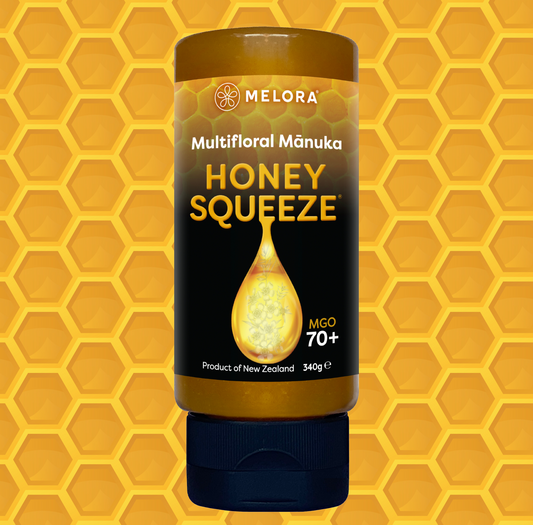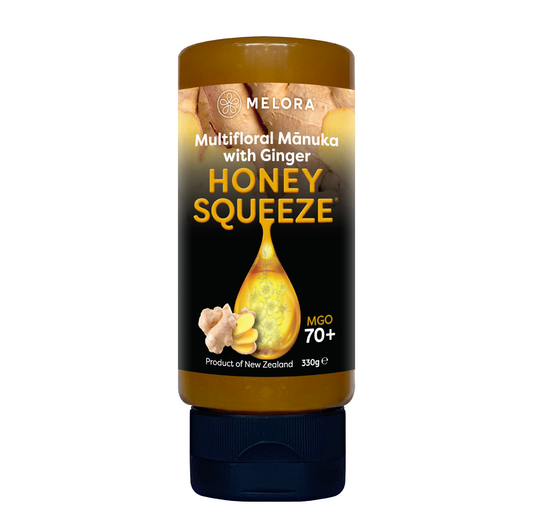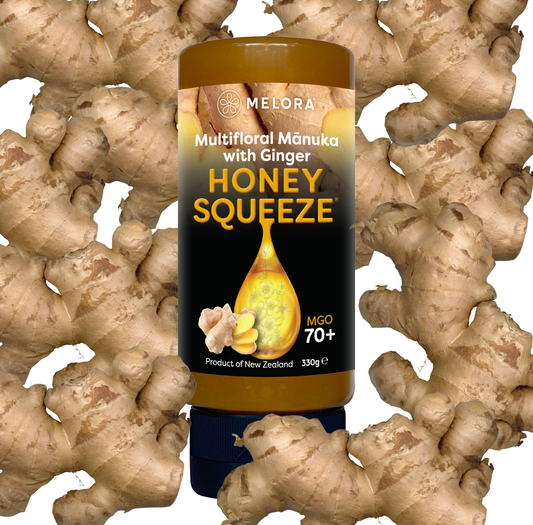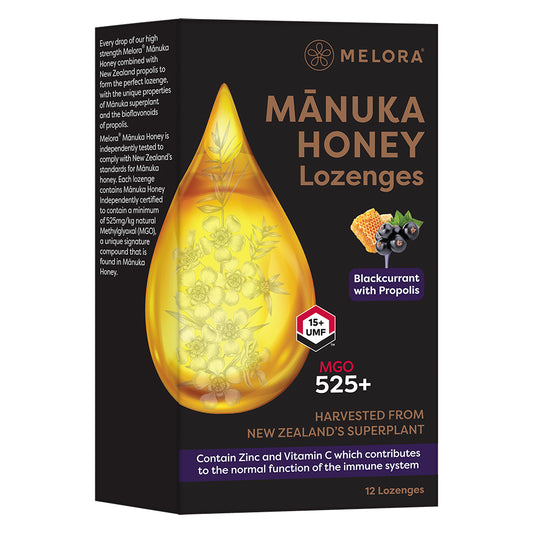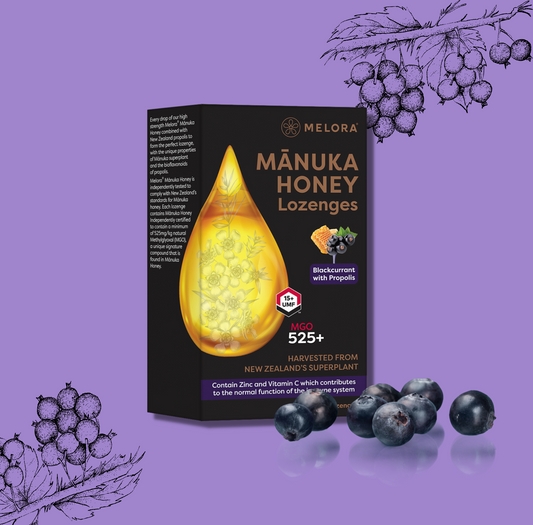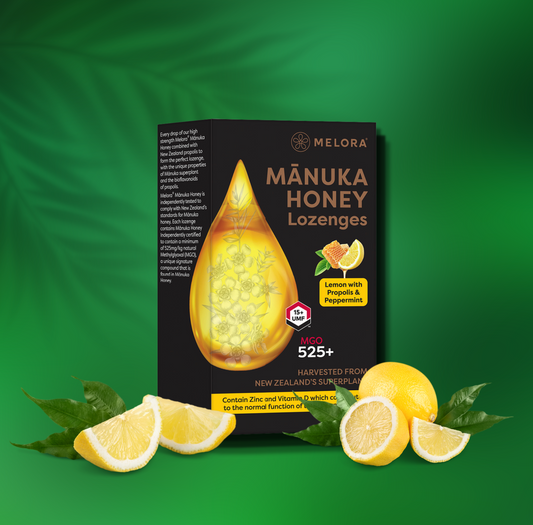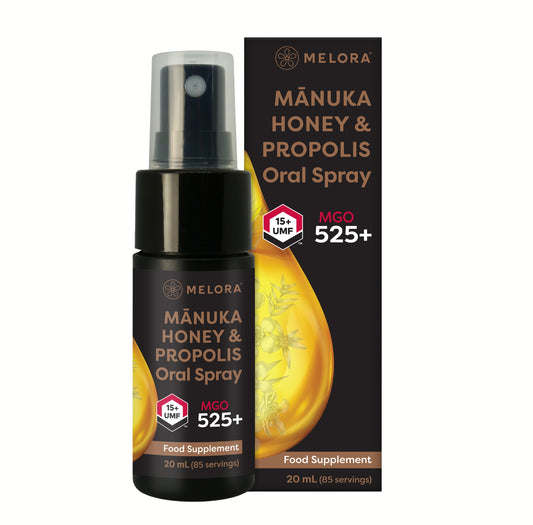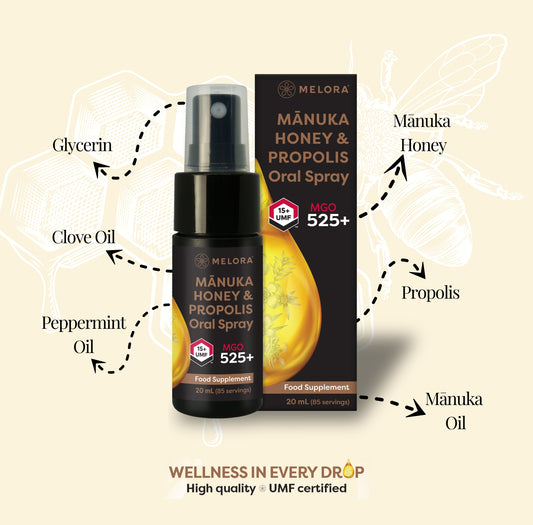Why You Should Buy MGO Mānuka Honey
Mānuka Honey comes from the Mānuka flower, otherwise known as the Leptospermum Scoparium flower. The flower mainly grows in New Zealand and is scientifically known for being the only honey which contains naturally occurring antibacterial activity, that is stable and can be measured.
All honey has some antibacterial activity, but with other honeys the activity changes with light, heat and processing. Only Mānuka’s unique antibacterial properties stay the same in the jar!
Mānuka honey stands out from other honeys thanks to its thick, creamy texture, deep amber colour, and unique earthy flavour with a subtle bitterness.
What are the benefits of Mānuka Honey.
Honey is recommended by the NHS to soothe sore throats and help ease coughs. Mānuka Honey is also known to have the following benefits:
-
Support digestive wellbeing, with a healthy diet.
The natural antimicrobial properties of Mānuka honey help maintain a healthy balance of gut bacteria, supporting digestive comfort and wellbeing.
-
Used to promote good oral hygiene.
Thanks to its potent antimicrobial action, Mānuka honey helps reduce harmful bacteria in the mouth, supporting oral health and fresh breath.
-
Treat burns, eczema and dermatitis, great for skin.
Mānuka honey’s unique antimicrobial and soothing qualities make it ideal for supporting wound healing and calming irritated skin.
What is MGO in Mānuka Honey?
MGO, or methylglyoxal, is the compound responsible for the unique antibacterial properties of Mānuka honey. This naturally occurring chemical is found in high concentrations in Mānuka honey, making it distinct from regular honey. The MGO rating on Mānuka honey products refers to the level of methylglyoxal present, which directly correlates to its antibacterial potency. The higher the MGO number, the stronger the honey's antimicrobial effects.
Mānuka honey's MGO levels make it an effective remedy for a variety of health conditions, from soothing sore throats to treating wounds and promoting oral health. MGO also contributes to the honey's longer shelf life and its ability to maintain its medicinal qualities even after being processed or exposed to light and heat. This grading system ensures that consumers can select the appropriate strength of Mānuka honey based on their specific needs, whether for daily consumption or more therapeutic purposes.
Which Manuka honey is best.
The traditional way to use Mānuka Honey is to have a small spoonful in the morning, 30 minutes before food.
40 MGO Daily use and in cooking. Cooking with Mānuka honey is a great way to add natural sweetener to your desserts and even on your savoury dishes. Follow our Instagram for more ideas.
100 MGO On porridge in smoothies, healthy snacks. Mānuka honey is great as a topper the bitter sweet taste adds a great flavour twist.
300 MGO Support a healthier lifestyle. Amazing with Lemon as a wellness tonic, to soothe and ease a sore throat and cough.
525 MGO High Strength, great in the morning and having straight just off the spoon.
850 MGO Rare and high strength, great for supporting your wellbeing, recommend a teaspoon in the morning so you can savour the stronger taste and make the most of the unique properties of this extra special 850 Mānuka honey.
Why Melora is the best quality MGO Mānuka Honey.
Natural and authentic MGO New Zealand Mānuka honey sourced sustainably and ethically.
Every drop of our Mānuka honey range is harvested from remote and untouched forestlands of New Zealand where the indigenous Mānuka bush naturally grow and thrive under the guardianship of our Māori landowner partners.
Independently tested and qualified, every drop of our Real New Zealand Mānuka honey contains over 2,300 unique components that contribute to its complex flavour and its remarkable benefits, making it one of the best Mānuka honey options available.
We can not ignore the reports of fake Mānuka honey, there are several brands that were tested in 2016 by The Grocer and the Daily Mail. Some brands did not meet the label claims. We are proud to a brand which has always been true to label. The strength on the label i.e 525MGO will be the strength of Mānuka honey in the jar. Every drop tested and checked before being packed and before leaving New Zealand, ensuring you’re always getting the best Mānuka honey.
Natural Chemical Markers:
1. MGO
MGO appraises the antibacterial activity in natural markers found in Mānuka. By seeing the MGO mark on our label, you can be sure what you buy from us is authentic Mānuka honey, showing the strength of the antimicrobial activity.
2. DHA
DHA measures the shelf life of Mānuka honey. To ensure the correct shelf life of Mānuka.
3. LEPTOSPERIN
Leptosperin is a natural chemical marker only found in the nectar of the Mānuka flower. By measuring the Leptosperin you can be assured that you have authentic Manuka.
4. HMF
HMF is another natural chemical marker called, hydroxymethyfurfural. This gives the assurance the Manuka is in the best condition and has not been stored or over heated, to ensure the Manuka has the unique properties it has become famous for.
We take great pride in our high-quality MGO Mānuka Honey, which is how we won gold in the International London honey 2022 Quality awards for our 525 Manuka Honey.
Our Manuka honey is sourced in the most sustainable and ethical way possible and we never compromise our standards. We believe the best quality honey is harvested by the beekeepers who respect the land, call it home and truly care for the bees, so we exclusively work with beekeepers who follow ethical practices and minimise environmental footprint. We also make sure economic benefits from our product sales are fairly returned to our landowner partners who share their precious Mānuka resource with us.
Frequently asked Questions:
How Much Manuka Honey per Day is recommended?
The daily intake of Mānuka honey can vary depending on individual health goals and the MGO content of the honey. Here is a general guideline based on the MGO levels:
40 MGO: Suitable for daily use, including in cooking and as a natural sweetener. A typical serving is about one to two teaspoons.
100 MGO: Ideal for use in porridge, smoothies, and snacks. A serving of one to two teaspoons per day is commonly recommended.
300 MGO: Designed to support a healthier lifestyle. For wellness uses such as a tonic with lemon to soothe the throat, one to two teaspoons per day is suggested.
525 MGO: Higher strength, typically consumed straight from the spoon or mixed into a warm beverage. One teaspoon in the morning is advised.
850 MGO: This rare and high strength honey is best enjoyed in small amounts to savour its unique properties. A teaspoon in the morning is recommended.
Always consider your dietary needs and consult with a healthcare provider if you have any specific health conditions or concerns about adding Mānuka honey to your diet. Mānuka honey is a potent natural product, and like all foods, should be consumed in moderation as part of a balanced diet.
What is the difference between Melora and Cheap Mānuka Honey?
We keep our Mānuka honey at an everyday low price and if you sign up to our mailing list, when we offer promotions you will be the first to be informed. We also have a subscription service offering an extra 5% off all monthly orders.
There are lots of Mānuka honey suppliers, some are shipping bulk to the UK and packing here to avoid some duty costs and cheaper shipping, others may be blending with cheaper honeys. We want you to have the best Mānuka honey and make this affordable for all.
What is the difference between monofloral and multifloral Mānuka honey?
Monofloral Mānuka honey comes from the nectar of the Mānuka bush, giving it higher purity, stronger flavour, and usually a higher MGO rating. Multifloral Mānuka honey is made when bees visit Mānuka as well as other flowers, resulting in a milder taste and a lower concentration of Mānuka’s unique properties. Monofloral is ideal for those seeking maximum potency, while multifloral is great for everyday use.
How do I know my Manuka honey is genuine?
Look for the MGO and UMF mark on the Jar.
Is Manuka a natural antibiotic?
Manuka contains natural antibacterial activity, its strength is determined by its MGO grade.
Is Manuka allowed during pregnancy?
Manuka has been taken by pregnant women for years, we do recommend you talk to your health visitor or midwife if you have any concerns.
Is Manuka allowed for a diabetic?
Honey is a great sugar substitute, taken in moderation and with a health professionals advise.
Is it okay to give Manuka to my baby?
The digestive systems of babies are not fully formed until 12 months, therefore the world health organisation advise against any honey to children under 12 months.
Is your Manuka raw?
All honey contains bee parts, pollen and parts of the honey comb, if we were to jar true raw honey it would be crunchy. Our Manuka is as raw as can be. Only filtered, so we retain the wonderful properties of our Manuka honey.
Is there a difference between UMF and MGO?
Yes, UMF is a quality system, managed by the UMFHA (Unique Manuka Factor Honey Association) and MGO (Methylglyoxal) is a grading system, which allows you to know the strength of the Manuka.
Does Manuka honey expire or go off?
Like all foods, Manuka has an expiry date. Like all honeys Manuka will not go bad, however the MGO strength on the label may not remain the same. For instance a 300MGO could possibly reduce down below 300MGO, albeit with a good Manuka honey this will take sometime to occur.
Can I give Manuka honey to my pets?
We hear lot of our customers and vets give Manuka honey to their dogs and horses, not only on their wounds to eat too. Please consult your local vet to understand how much is safe for your pet.




